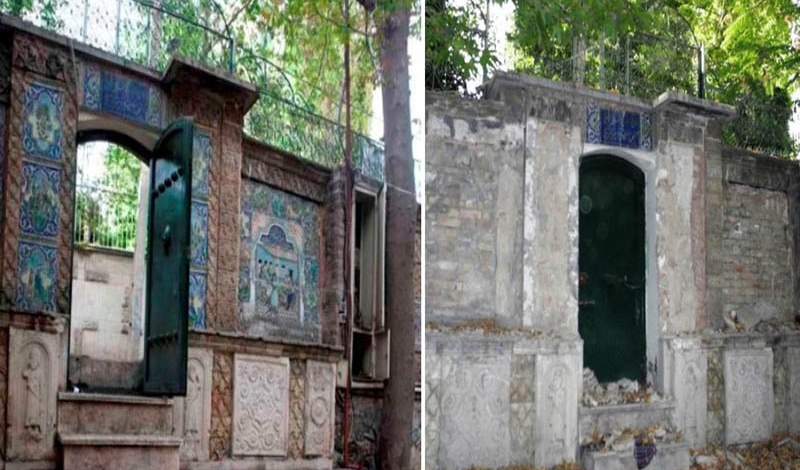 TEHRAN, March 15 (MNA) � Tehran�s historical houses are dying gradually. They give Tehran its identity. Many of these houses are vacant and thus are home to addicts and the homeless.
TEHRAN, March 15 (MNA) � Tehran�s historical houses are dying gradually. They give Tehran its identity. Many of these houses are vacant and thus are home to addicts and the homeless.These houses are subject to the greed of cheap mass house constructors, and every day, one of such historical houses falls victim to the bulldozers and heavy construction machines, and a brick house, with a yard full of trees, a small bond and wooden window is replaced by tall, spiritless concrete-and-steel multi-floor towers.
Etehadiyeh Mansion and Garden is one such example in Tehran which is bidding farewell.
Mehr Magazine: in early April 2012 it was reported that a committee, �Committee to Address Tehran�s Historical Buildings,� established, with initial motive being to save Amin al-Soltan Garden (Etehadiyeh), to address the unfortunate situation of some of capital�s historical houses. At that time, Sajjad Asgari, who was the secretary of the Committee, emphasized on the �squaring away� of Etehadiyeh Garden. �According to statements by Heritage Organization experts, city planning managers and NGOs, Amin al-Soltan (Etehadiyeh) Garden is Tehran�s identity and the beating heart of Lalehzar and Ferdowsi neighborhoods,� he added, �it is the only surviving historical gardens in Iran of Fathalishah era, the destruction of which greatly damages the city�s heritage, establishing a precedent where the owners of these historical houses would bring down the building after they removed these houses from official list of national monuments.�
He mourned that with current pace of destructions, �by the next 10 years, no historical building would stand in Tehran.�
After three years of establishment of the Committee and surfacing the plight of historical houses, Etehadiyeh lives no good days. Etehadiyeh Garden is not the only historical monument subjected to destruction. ISNA had reported some while ago that the house of Mohammad Mirza Kashef al-Saltaneh, the father of tea industry in Iran and the first tea importer, had been pillaged by the derelicts.
This house was, according to history, the home to Amin al-Soltan, the chancellor to Naseredin Shah, Mozafaredin, and Mohammad Ali Shah of Qajar. Haj Rahim Etehadiyeh purchased the garden after Atabak� death; however, now it is subject to destruction and pillage.
Doors, windows, and roofs fall to gradual destruction in daily basis.
Trees of the garden have no better conditions. Their boughs are cut, and only a dry, spiritless torso remains.
Inner decorations even have more unfortunate situation.

The house of �father of Iran�s tea,� located in Shemiran neighborhood, Shariati St., is among the most valuable monuments. Yet it has not been registered in the Heritage Organization list of national monuments.

Beautiful decorations and tiles of this house have been plundered.

Having been plundered, this house was sold for $ 8.2m. The neighbors say the new owner would demolish the monument and build house or business hub in the place.

Moshirodoleh (Pirnia) Building in Lalehzar St. lives a similar condition. It has not been registered by the Heritage Organization. Hassan Pirnia, nicknamed Moshirodoleh is the author of the first book about history of ancient Iran and first codified international rights pamphlet in Persian. His house was home where the historic Constitutional Law was written.

In last September, the house was auctioned $ 4m. Long before, the beautiful paintings in the walls had been stolen.

Zoherioleslam House in Shahid Ghaedi St. (formerly Hedayat St.) finds the worse situation every day. Doors and windows were stolen, and the fire has consumed part of the house. The paved pond and stepping stones are subject to ruin.

The house is reportedly belonged to Seyed Zein al-Abedin, the Friday Prayer Imam, also nicknamed Zoheiroleslam, Naseredin shah�s son-in-law. The house had gone under the control of Social Security Organization, Properties and Assets Office.

The house was long before home to municipality workers, addicts, and even the homeless. However, a court order was solicited by the Social Security legal office and the addicts living in the house was dismissed.

The house was registered in Heritage Organization official list of historical monuments. Few years later, the municipality of District 12 of Tehran destroyed the walls surrounding the house with the pretext of the threat of collapse.
By Mehr News Agency
The Iran Project is not responsible for the content of quoted articles.











